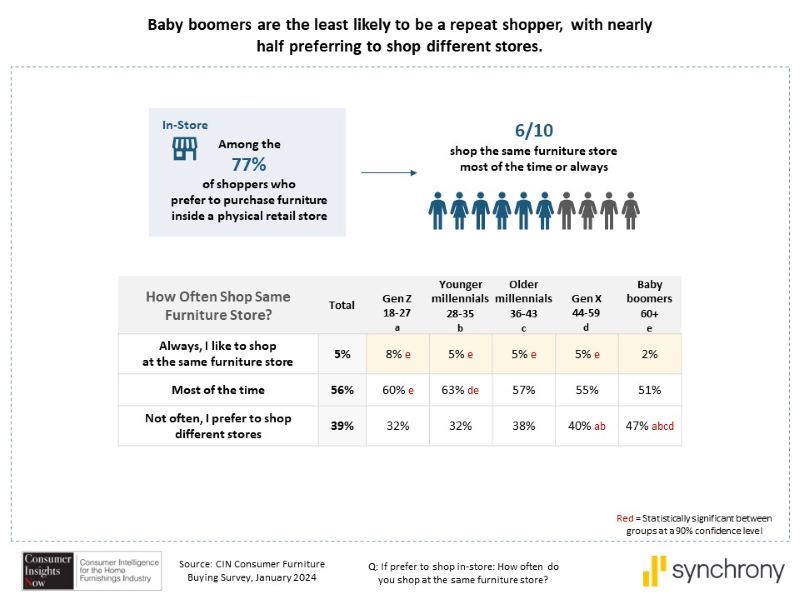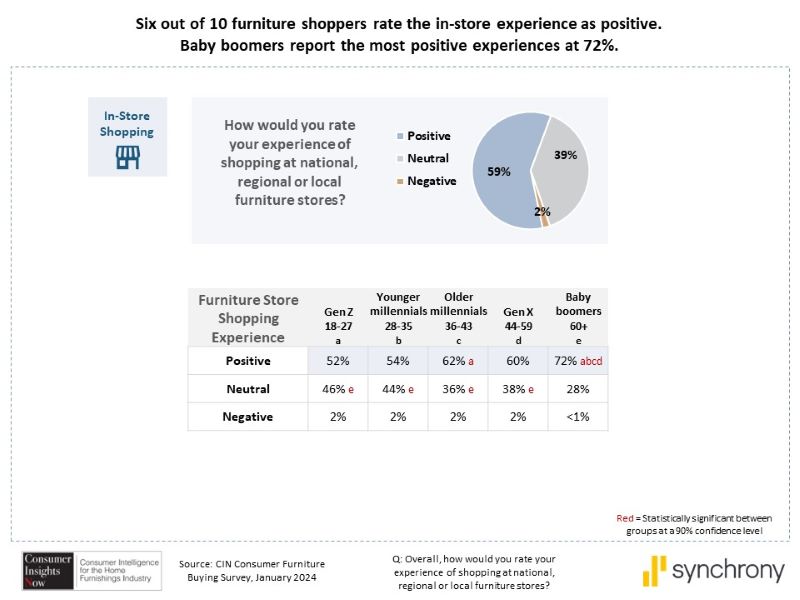While most plan to make purchases in a brick-and-mortar store, showrooming is become more commonplace, particularly among younger consumers
HIGH POINT — Brick-and-mortar retailers will be glad to know that most people in the market for furniture prefer to buy at a physical store location.
That’s a key finding in our sixth and final Consumer Insights Now research of the season published at the tail end of the spring High Point Market.
According to the survey of some 1,800 consumers that plan to buy furniture in the first half of this year, 77% said they prefer to buy products in-store versus online. This ranged from a low of 69% for younger millennials ages 28-35 to upwards of 89% for baby boomers ages 60 and over.

However, some 44% also admitted to showrooming, the practice of looking at a product in-store then purchasing it online. The survey shows that this is more common among younger consumers, with the results of those having done this in the past ranging from 52% for older millennials ages 36-43 to 56% for those ages 18-27. Older consumers said they were less likely to showroom, including 61% of Gen Xers ages 44-59 and 76% of baby boomers over 60.
The top five products that consumers bought online after seeing them in the store included sofas and sectionals (43%), bedroom furniture (30%), mattresses (29%), occasional tables (24%) and office furniture (23%), followed by area rugs (22%), entertainment furniture and recliners (21%), dining furniture (19%) and outdoor furniture (15%).
The research also offered specific insights into why each group of consumers chose one shopping experience over the other.
Here are some responses in favor of brick-and-mortar stores:

+ “I like to test out the product by sitting on it or laying on it. I also like to see what varieties are there and talk to the salesperson.”
+ I love the convenience of shopping locally and looking at the furniture in person.”
+ I enjoy seeing the furniture in person. I also like having a salesperson there with me to explain all the features and the pricing.”
+ I enjoy wandering around the showrooms. It gives you the experience of imagining these furniture pieces being in your home.”
+ Being able to sit, lay or lounge in person allows you to notice the grain of the wood, the texture of the fabric and the comfort and softness of the mattress.”
+ The salespeople are friendly and helpful.”
And here is what people said about the online experience:
+ “I wanted to see how it looked in person, but there was a better deal if I bought online.”
+ “I browse to see what’s available first then shop online for the better price.”
+ “I wanted to feel and lay down on the mattress before buying it on sale online.”
+ “Online will ship it right to my home so I don’t have to figure out how to get the furniture home.”
+ “It’s easier to get it delivered by buying online.”
+ Salespeople at furniture stores are usually pushy trying for a commission. It annoys me, so I buy online after making my choice in-store.
Thus, different people have had different experiences, particularly with salespeople and perceived pricing between in-store and online.
The good news for brick-and-mortar stores is that they received plenty of other high marks in areas such as offering competitive prices, offering good values, selling high-quality brands and offering on-trend styles. But some of these scores also were similar to the online experience, meaning there is room for both options in the minds of consumers. They each received high marks for being convenient to shop, although online retailers ranked slightly higher than national furniture and mattress chains and local or regional furniture and mattress stores.

In terms of quality customer service, brick-and-mortar stores, however, ranked higher than online platforms in almost every category (local and regional furniture and mattress stores to national furniture and mattress chains).
The survey also offers hints of how brick-and-mortar stores can do better with those consumers that prefer to shop there versus online. Below are some of the responses.
+ “The sales associates try way too hard to sell you things you do not need.”
+ “More options and knowledge from the sales associate.”
+ Have all the furniture displayed, but then (make it) purchasable online (the store website) after I find out what I want.”
+ Better prices, options and salespeople that don’t pressure and have all the answers to my questions.”
+ Make it more trendy.”
+ Better deals and prices.”
Many retailers are already doing a good job in these areas, from offering the latest trends and styles on their floors to making sure their salespeople are better trained in how to be there for the customer when needed and being able to provide honest and accurate information about the products on the floor.
This summary obviously just scratches the surface of the survey results. For more details and specific numbers based on the responses, click here. Until our next round of research later this year, we hope this information proves useful in running your business and provides some insight into the wants, needs and expectations of your customer base.





